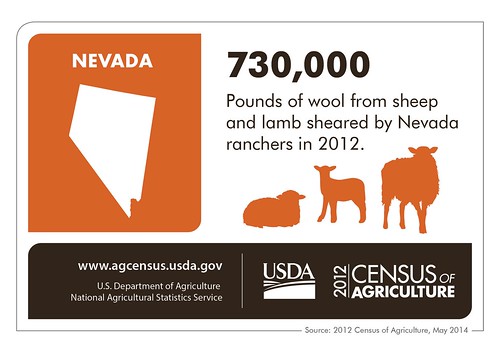
The Census of Agriculture is the most complete account of U.S. farms and ranches and the people who operate them. Every Thursday USDA’s National Agricultural Statistics Service will highlight new Census data and the power of the information to shape the future of American agriculture.
When people think of Nevada, most imagine Las Vegas with its casinos and other entertainment venues, or a vast expanse of dry land. Few imagine a dynamic agricultural sector fueled by farming and ranching. In reality, however, Nevada had one of the fastest growing agriculture sectors in the nation according to the 2012 Census of Agriculture.
In 2012, Nevada’s producers sold more than $764 million worth of agricultural products, a whopping 49 percent increase since the 2007 Census. All of these products were grown and raised on Nevada’s 4,137 farms and ranches. Since 2007, the number of our farms has grown 32 percent. Nevada also boasts some of the largest agricultural operations in the nation. According to the 2012 Census, an average size of a Nevada farm or ranch was 1,429 acres. Only three states, Wyoming, Montana, and New Mexico average larger farm sizes than Nevada.
Here in Nevada, our ranchers maintain a robust livestock sector. Cattle ranching is one of our staples, and the 2012 Census of Agriculture counted more than 420,000 head of cattle in the Silver State. Our ranchers also have the 16th largest number of sheep and lamb, totaling nearly 92,000 in 2012. That year, our ranchers sheared more than 730,000 pounds of wool.
Not surprisingly, Nevada’s crop industry is focused on supporting our livestock infrastructure. The largest component of our crop sector is hay production. Our farmers produced almost 1.8 million tons of hay from 525,000 acres and sold it for more than $280 million in 2012. Other than hay, wheat is our top crop. In 2012, Nevada farmers harvested 18,239 acres of wheat.
Nevada farmers and ranchers are also beginning to make inroads into new agricultural practices. In 2012, 288 Nevada operations sold value-added products, such as bread, cheese, preserves and similar items. Sixty-seven of our farms also participated in Community Supported Agriculture arrangements, bringing their products directly to consumers. On-farm renewable energy production is another innovative practice our farmers are picking up. In 2012, 23 of our farms produced their own on-farm renewable energy.
With so much growth and still so much unrealized potential, Nevada farming has a very bright future. But we don’t have to wait too long to see what the near future holds for our farmers and ranchers. Already NASS is preparing for the 2017 Census of Agriculture. So in just a few short years, we’ll be able to see if Nevada agriculture continues on its upward trajectory.


